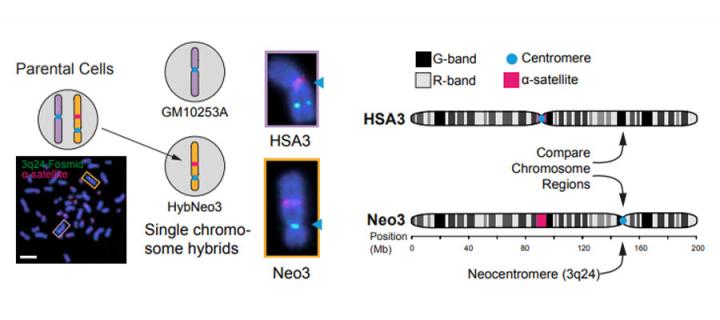Human centromere repositioning activates transcription and opens chromatin fibre structure
Summary: A team of researchers from the MRC Human Genetics Unit use neocentromeres as a model system to provide insight into the properties of canonical centromeres: September 2022

Cells in our body are continuously dividing to produce more cells that are genetically identical to themselves- a process called mitosis. During this process, the DNA of the cell's nucleus is split into two equal sets of chromosomes. This is usually done in a carefully organised series of steps as unequal division of the DNA between cells can cause genetic instability and may lead to diseases such as cancer.
As cells prepare to divide, the chromosomes are replicated to form two 'daughter' strands known as sister chromatids. These are held together by a structure called centromeres. Centromeres are highly specialised DNA sequences that play an important role in the separation of the sister chromatids. The centromere is necessary to maintain genome stability during cell division, but it is still not clear how it works.
Studying centromeres has been challenging as they contain special regions of repetitive DNA sequence that are very hard to read and work with compared to DNA away from the centromere. To overcome this, Naughton and colleagues generated a model system using neocentromeres. Neocentromeres are new centromeres that forms on a chromosome at a region that is normally not centromeric. Although they are functionally and structurally similar to normal centromeres, they do not contain repetitive sequences. This makes them a powerful tool to investigate centromeric chromatin structure.
Due to the repetitive nature of human centromeres it has been impossible to characterise their chromatin structure. In our study we get around this by taking advantage of the properties of neocentromeres to develop a model system which we used to analyse centromeric chromatin. This understanding of centromere chromatin structure paves the way for important further studies on centromere function, kinetochore assembly and chromosome evolution.
The researchers show that chromatin structure at the centromere has an 'open' configuration and this likely is important for how the centromere works. They also demonstrate that the process of transcription is necessary to achieve the open structure. They hypothesise that the remodelling of the chromatin fibre forms a suitable environment for proteins that need to bind to the centromere during mitosis. In contrast, they found the surrounding chromatin regions were remodelled to form a compact structure and suggest this is to give structural rigidity. These findings provide insights into the properties of normal centromeres.
Links
Original article: Naughton, C., Huidobro, C., Catacchio, C.R. et al. Human centromere repositioning activates transcription and opens chromatin fibre structure. Nat Commun 13, 5609 (2022). https://doi.org/10.1038/s41467-022-33426-2


